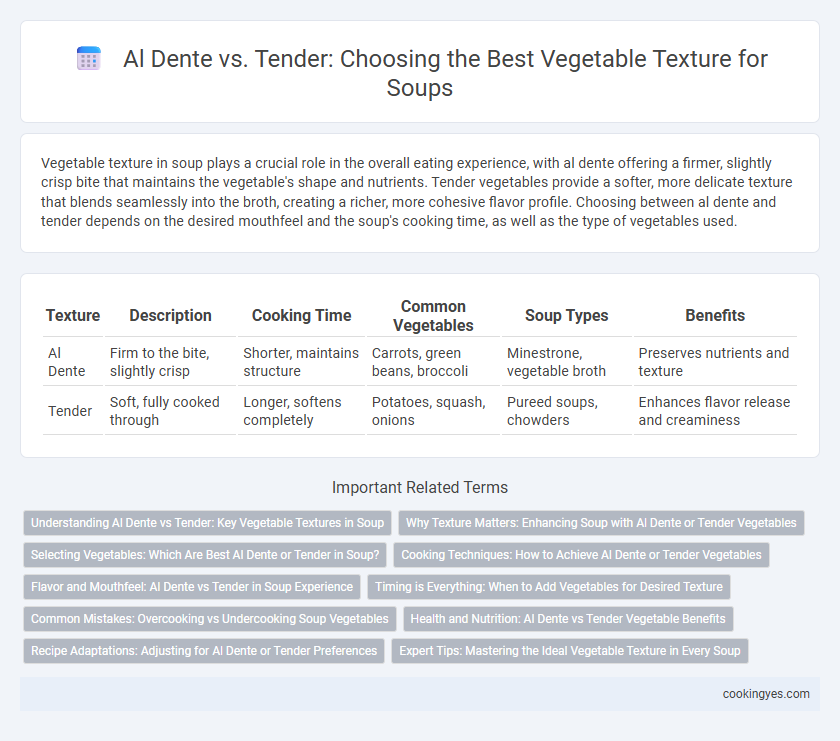Vegetable texture in soup plays a crucial role in the overall eating experience, with al dente offering a firmer, slightly crisp bite that maintains the vegetable's shape and nutrients. Tender vegetables provide a softer, more delicate texture that blends seamlessly into the broth, creating a richer, more cohesive flavor profile. Choosing between al dente and tender depends on the desired mouthfeel and the soup's cooking time, as well as the type of vegetables used.
Table of Comparison
| Texture | Description | Cooking Time | Common Vegetables | Soup Types | Benefits |
|---|---|---|---|---|---|
| Al Dente | Firm to the bite, slightly crisp | Shorter, maintains structure | Carrots, green beans, broccoli | Minestrone, vegetable broth | Preserves nutrients and texture |
| Tender | Soft, fully cooked through | Longer, softens completely | Potatoes, squash, onions | Pureed soups, chowders | Enhances flavor release and creaminess |
Understanding Al Dente vs Tender: Key Vegetable Textures in Soup
Al dente vegetable texture in soup offers a slight firmness that retains the vegetable's shape and provides a satisfying bite, enhancing visual appeal and mouthfeel. Tender vegetables, by contrast, are fully cooked and soft, allowing flavors to meld seamlessly into the broth while creating a comforting, smooth consistency. Choosing between al dente and tender depends on the desired texture contrast and the specific soup recipe's flavor profile, whether a vibrant vegetable medley or a creamy puree.
Why Texture Matters: Enhancing Soup with Al Dente or Tender Vegetables
Vegetable texture in soup significantly influences both mouthfeel and flavor release, with al dente vegetables providing a firm bite that preserves individual taste and visual appeal. Tender vegetables, cooked until soft, contribute to a smoother, creamier consistency that enhances the soup's overall comfort and digestibility. Choosing between al dente and tender vegetables depends on the desired soup style, where al dente favors freshness and contrast, and tender promotes warmth and homogeneity.
Selecting Vegetables: Which Are Best Al Dente or Tender in Soup?
Selecting vegetables for soup depends on desired texture; carrots, green beans, and broccoli often work best al dente to maintain crunch and color, enhancing visual appeal and mouthfeel. Root vegetables like potatoes, parsnips, and squash benefit from a tender cook, releasing natural sweetness and thickening the broth for a comforting consistency. Balancing al dente with tender vegetables creates a dynamic texture profile, elevating the overall soup experience.
Cooking Techniques: How to Achieve Al Dente or Tender Vegetables
Achieving al dente vegetables in soup requires briefly blanching or simmering just until they are tender yet firm, preserving their bite and nutritional value. For tender vegetables, longer simmering or slow cooking breaks down cell walls, resulting in a softer texture that melds seamlessly with broth flavors. Adjusting cooking time and temperature based on vegetable type ensures the desired texture, enhancing the overall soup experience.
Flavor and Mouthfeel: Al Dente vs Tender in Soup Experience
Vegetables cooked al dente in soup retain a firmer texture, offering a slight resistance that enhances the mouthfeel and preserves more vibrant, distinct flavors. Tender vegetables, by contrast, blend smoothly into the broth, creating a softer, more harmonious flavor profile but with a less pronounced bite. The choice between al dente and tender textures significantly impacts the overall sensory experience, balancing freshness and softness to suit different soup styles.
Timing is Everything: When to Add Vegetables for Desired Texture
Timing is everything when adding vegetables to soup to achieve the perfect texture, whether al dente or tender. Harder vegetables like carrots and potatoes require longer cooking times, typically 20-30 minutes, to become tender, while quicker-cooking vegetables such as peas or spinach should be added in the last 5 minutes for a slight crunch. Adjusting the cooking sequence ensures each vegetable retains its ideal texture, enhancing overall soup quality and flavor.
Common Mistakes: Overcooking vs Undercooking Soup Vegetables
Overcooking soup vegetables results in a mushy, flavorless texture, while undercooking leaves them too firm and starchy, detracting from the overall dish. Achieving the ideal al dente texture enhances both the taste and mouthfeel, preserving the natural sweetness and nutrients of carrots, celery, and green beans. Avoiding common mistakes involves precise timing and monitoring vegetable size to ensure even cooking and optimal texture balance in soups.
Health and Nutrition: Al Dente vs Tender Vegetable Benefits
Al dente vegetables in soup retain more fiber and vitamins due to shorter cooking times, promoting better digestion and nutrient absorption. Tender vegetables, while easier to chew and digest, may lose some water-soluble nutrients like vitamin C during prolonged cooking. Choosing al dente textures supports higher antioxidant levels and glycemic control, benefiting overall health.
Recipe Adaptations: Adjusting for Al Dente or Tender Preferences
Adjust soup recipes by varying cooking times to achieve either al dente or tender vegetable textures. For al dente, reduce simmering and add vegetables later in the cooking process to maintain a slight crunch. To reach tenderness, extend cooking time, allowing vegetables to soften fully and integrate more deeply into the soup's flavors.
Expert Tips: Mastering the Ideal Vegetable Texture in Every Soup
Achieving the perfect vegetable texture in soup requires balancing al dente crispness and tender softness to enhance both flavor and mouthfeel. Experts recommend starting with tougher vegetables like carrots or potatoes, cooking them until just tender, while adding delicate vegetables such as peas or green beans later to maintain a slight bite. Mastering precise cooking times and monitoring texture ensures each vegetable contributes distinct layers, elevating the overall soup experience.
Al dente vs Tender for Vegetable Texture in Soup Infographic

 cookingyes.com
cookingyes.com